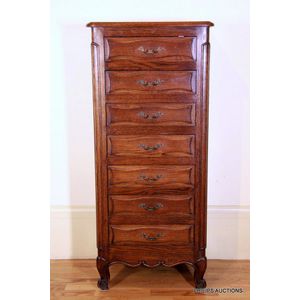1920s Walnut Chest of Drawers
You must be a subscriber, and be logged in to view price and dealer details.
Subscribe Now to view actual auction price for this item
When you subscribe, you have the option of setting the currency in which to display prices to $Au, $US, $NZ or Stg.
- Apron - A decorative wooden panel that sits underneath the top surface of a table or chair, and unites the top of the piece with the legs, running at right angles to the underside. On carcase furniture such as a chest or wardrobe, the apron sits below the drawers or doors and attaches to the legs.
On carcase furniture without legs the panel under the drawers or doors sits on the floor and is termed a plinth.
An apron can provide a decorative touch to an otherwise unadorned piece of furniture and at the same time provide structural support and strength. They can be carved or pierced and quite elaborate. - Circa - A Latin term meaning 'about', often used in the antique trade to give an approximate date for the piece, usually considered to be five years on either side of the circa year. Thus, circa 1900 means the piece was made about 1900, probably between 1895 and 1905. The expression is sometimes abbreviated to c.1900.
- Serpentine - Resembling a serpent, in the form of an elongated 'S'. A serpentine front is similar to a bow front, except that the curve is shallow at each end, swelling towards the middle. The term presumably derives from its similarity to a moving snake or serpent. Serpentine fronts are usually veneered, with the carcase either being cut and shaped from a solid piece of timber, or built in the 'brick' method.
- Canted Corners - In decorative arts, especially furniture making, a canted corner refers to a technique where the corner of the piece is angled or "canted" to create a diagonal corner. This is different from a chamfered corner which is a technique where the edges of a corner are cut at an angle, creating a diagonal edge or "bevel" along the corner.
A canted corner is typically used to add visual interest to the item. It can be found in various styles of furniture such as contemporary, Art Deco, or traditional. It is often used to create a sense of movement and dynamism in a piece.
Canting a corner is a more complex technique than chamfering, and it is typically done by tilting the corner of a piece of furniture and then cutting the wood to match the angle. It's a technique that requires precise measurements and a good understanding of angles and geometry, and it is usually done by experienced artisans. - Cabriole Leg - The cabriole leg evolved from an elongated scroll, curving out at the knee which may or may not be carved, and forming a serpentine shape as it descends to the foot.
First introduced into English furniture in the late 17th century, cabriole legs were widely used during the Queen Anne and early Georgian periods, where they frequently terminated in a pad foot or ball and claw foot. The style has had many imitators since then. The cabriole leg was re-introduced in the mid-19th century, and is commonly associated with the balloon-back dining or drawing-room chairs made in walnut, mahogany or, in Australia, cedar. The Victorian cabriole leg, on the whole, was rather more slender than the earlier form, following the French style, which emphasized the delicacy and daintiness of the chairs they were designed to support. Cabriole legs are sometimes found on windsor chairs, especially those made during the 18th century. - Pad Foot - In furniture design, a pad foot refers to a type of
furniture foot that is shaped like a flattened ball or pad. It is a common
design element in traditional furniture styles, particularly in English and
American furniture from the 18th and 19th centuries. The pad foot is typically
wider than it is tall, with a broad, flat surface that rests directly on the
floor. It is often carved or turned with decorative details, such as fluting or
ridges, and can be made from a variety of materials, such as wood, metal, or
leather.
Pad feet are used to support the legs of various types of
furniture, such as chairs, tables, and cabinets. They are often used in
combination with other types of feet, such as bun feet or bracket feet, to
create a more complex and decorative furniture design. In terms of
functionality, pad feet provide stability and support to furniture pieces, and
can help distribute the weight of the piece evenly across the floor. In terms
of design, they add a classic and traditional look to furniture designs, and
are often used to create a sense of elegance and refinement.
This item has been included into following indexes:
Visually similar items

A French Louis XV style walnut tall chest, the yellow shaped marble top, above seven drawers, flanked by canted corners, with a shaped apron, on tapering supports, with ormolu sabots. 110 cm high, 46 cm wide, 32 cm deep.

A Victorian cedar chest, circa 1860s, with an extended serpentine top above a central drawer with applied embellishments in low relief, flanked by pairs of two small drawers, three long drawer below of graduating depth and all with timber knob handles. Hei

Arts & craft oak bureau desk, 60.5 cm wide, 123 cm high

A Regence style oak semainier, circa 1930s, the semainier with short drawers with fielded panels and cast foliate pull handles, reeded and rounded edges, with a shaped apron and raised on short cabriole legs, height 129 cm, width 58 cm, depth 40 cm
